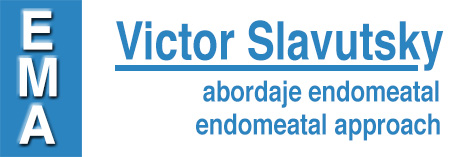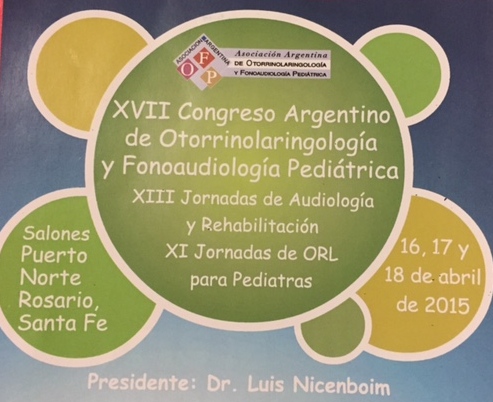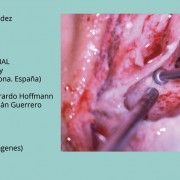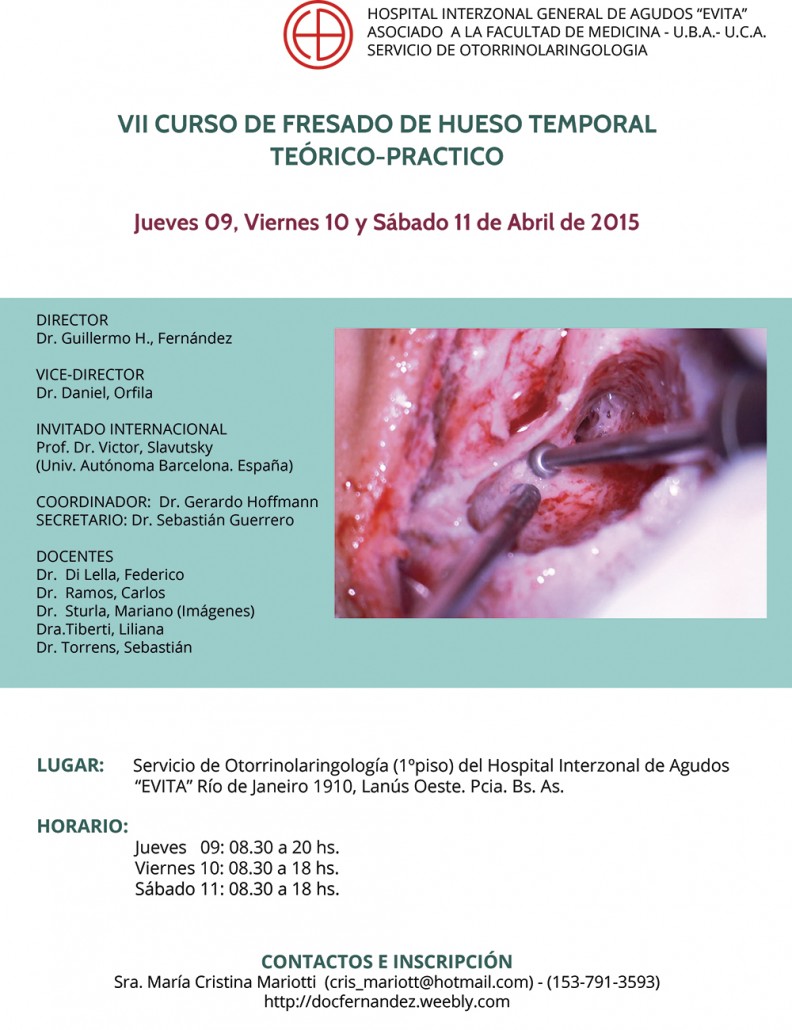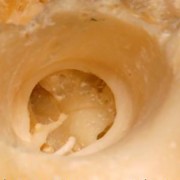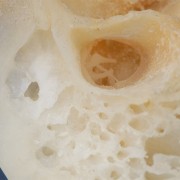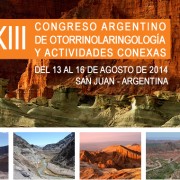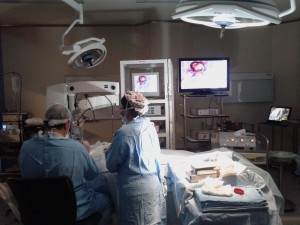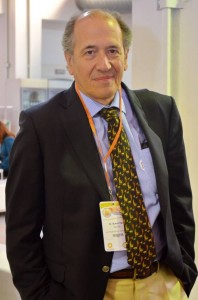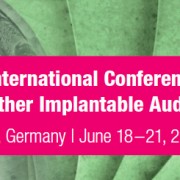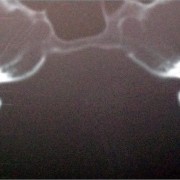VII curso de fresado de hueso temporal. Cirugía endomeatal.
/en Eventos /por adminVII curso de fresado de hueso temporal. Cirugía endomeatal.
Temporal bone Lab.Endomeatal surgery
9 al 11 de abril de 2015.
Hospital interzonal general de agudos «Evita». Rio de Janeiro 1910, Lanús Oeste. Buenos Aires.
Contacto e inscripción:
Sra. María Cristina Mariotti
T: 153 791 3593
Porqué el abordaje endomeatal (EMA) Why the endomeatal approach (EMA)
/0 Comentarios/en EMA /por adminEMA – CONCEPTO
La cirugía general a través de orificios naturales se denomina N.O.T.E.S. (NATURAL ORIFICES TRANSLUMINAL ENDOSCOPIC SURGERY) y marca la evolución de las técnicas quirúrgicas actuales. El mismo concepto aplicado a la cirugía otologica, se denomina E.M.A. (ENDOMEATAL APPROACH), en donde los orificios naturales son los meatos auditivos.
Las ventajas de este procedimiento son evidentes,ya que permiten respetar los tejidos sanos y su función,específicamente el M.A.C.S., el sistema de aireación mastoideo del que depende el resultado funcional y la recidiva de la patología .
El EMA es una técnica mínimamente invasiva, la agresión quirúrgica es menor,el post operatorio mas simple y los resultados funcionales mas favorables. Es una cirugía ambulatoria, en la mayoría de los casos.Las distintas patologías otológicas pueden ser resueltas mediante el EMA. Es una cirugía atraumática de todo el hueso temporal.
Reconoce un meato auditivo principal y tres meatos auditivos accesorios:
Meato auditivo principal:
- Meato auditivo externo (MAE)
Meatos auditivos accesorios:
- Meato de la ventana oval (VO)
- Meato de la ventana redonda (VR)
- Meato tubárico (MT)
CARACTERISTICAS DEL EMA
- Controla el espacio quirúrgico adicional
- Cirugía mínimamente invasiva
- Inicia la cirugía en el origen de la patología
- Limita la extensión del abordaje
- Practica incisiones mínimas
- Respeta los tejidos sanos
- Preserva la función de las estructuras anatómicas (MACS-mastoid air cell system)
- Facilita un post operatorio mas simple
- Favorece el resultado funcional
EMA – CONCEPT
General surgery through natural orifices named NOTES (NATURAL ORIFICES TRANSLUMINAL ENDOSCOPIC SURGERY ) brand evolution of actual surgical techniques.Same concept applied to otologic surgery, named EMA (ENDOMEATAL APPROACH) wherein the natural orifices are the auditory meatus.
Advantages of this procedure are obvious, allowing respecting healthy tissues and its function, specifically the MACS , mastoid aeration system in which depends functional outcomes and recurrence of the disease .
EMA is a minimally invasive surgical technique, less aggressive,with simpler post operative period and better functional results.It is an outpatient surgery, in most of the cases.All different otologic diseases can be resolved with EMA, an atraumatic ear surgery.
Recognizes a main auditory meatus:the external auditory meatus and the accessories meatus:round window,oval window and tubal meatus.
Nota
Disecciones anatómicas. Colaboración Dr.Rodrigo Posada Trujillo (Colombia)
Fisiología de la mastoides: aviso a los cirujanos
/0 Comentarios/en EMA /por adminInsights in the phisiology of the mastoid bone: message to the surgeon
ENT Department – University Hospital Antwerp and Temporal Bone Foundation, Brussels Avenue du Polo 68 B-1150 Brussel Belgium (BA, NCP) Laboratory of BioMedical Physics – University of Antwerp Groenenborgerlaan 171 B-2020 Antwerpen Belgium (JD, JB)Bernard Ars, Joris Dirckx, Nicole Ars-Piret, Jan Buytaertmacs-Int. Adv. Otol. 2012; 8:(2) 296-310
To reach the temporal bone, surgeons often consider making access through the mastoid. It is, however, imperative that the surgeon is aware of the mastoid’s morphology, physiology, its functional parameters and the implications of damaging or altering this structure.
We review established findings on the developmental and functional morphology, and the delicate pressure balance variations in the middle ear cleft. Then, an overview is given of the possible surgical access methods for the temporal bone through the mastoid. We look for implications of each procedure, which can only be understood through the knowledge of the preceding outline, so that surgeons can justify a certain surgical approach.
El EMA y el sistema de aireación mastoideo (MACS)
Tesis Doctoral -Victor Slavutsky ( ver EMA.Implante Coclear.Pgs.10-12)
Siguiendo la filosofía conceptual de este abordaje y su respeto por los tejidos sanos, el EMA a diferencia de los abordajes transmastoideos preserva y no destruye el Sistema de Aireación Mastoideo (MACS), que permite la difusión de gases ,mantener la temperatura y la presión del oído medio.
Este artículo complementa el anterior y demuestra la importancia del MACS en la cirugía de la mastoides.
El EMA es el abordaje que mejor conserva este Sistema de aireación del oído medio,con la técnica semiabierta (ver Colesteatoma)
Congreso argentino ORL – Curso de cirugía otológica endomeatal
/0 Comentarios/en Prensa /por adminNOTA DE PRENSA.
Fuente: Ministerio de Salud Pública.14 DE AGOSTO DE 2014 .
Periódico tiempo de San Juan.
XXXIII Congreso Argentino – San Juan. DR. VÍCTOR SLAVUTSKY
En el marco del XXXIII Congreso Argentino de Otorrinolaringología que se realiza en la ciudad desde el 13 al 16 de agosto, llegó el Dr. Víctor Slavutsky, un sanjuanino que está radicado en España desde hace 40 años, es un destacado médico internacional especialista en ORL formado en la Universidad Autónoma de Barcelona y médico adjunto del servicio de ORL del Hospital San Camilo de Barcelona.
En su visita a San Juan realizó dos cirugías en el Hospital Dr. Guillermo Rawson a dos pacientes que tenían una deficiencia auditiva a los cuales se les restauró esa función. Dichas intervenciones emplearon una técnica diferente y poco habitual porque se operó a través de orificios naturales, con lo cual la cirugía es mucho más simple y el paciente recibe menos agresión quirúrgica.
13th International Conference on Cochlear Implants – Munich 2014
/0 Comentarios/en Cochlear, EMA, Prensa /por admin13th International Conference on Cochlear Implants – Munich 2014
Dr. Victor Slavutsky was invited to the «13th International Conference on Cochlear Implants».
Faculty member of «Endoscopic cochlear implantation». Conference about «Cochlear implant surgery through natural orifices».
Video-surgery session: «Endomeatal approach (EMA) partially ossified cochlea».
Endomeatal approach (EMA) partially ossified cochlea
Introduction: Cochlear ossification is a challenge for CI surgery, due to the difficulty of electrode array insertion. Surgery through anatomical natural orifices (external auditory canal and round window) avoids facial nerve (FN) and internal carotid artery (ICA) risks
Objective: The objective of this original technique: endomeatal double cochleostomy with standard electrode array is to approach in a safe manner ossified cochleas, where usual anatomical landmarks are unclear.
Material and method: Technique was developed in temporal bone Lab and then applied in 4 patients. EMA allows access to all the turns of the cochlea from base to apex. The advantage lies mainly in that the middle and inner ear access is addressed in front of the posterior wall instead of coming behind it, overcoming those limitations. This technique allows to start drilling in an endomeatal manner the basal cochlear turn from the round window until the cochlear lumen is reached, (4,5mm +/–). Second cochleostomy is performed in the middle turn, which controls the correct positioning of electrode array, during insertion, and if it is not possible a reverse insertion from middle turn cochleostomy to basal turn direction, can be attempted. The video case presented is a partial cochlear ossification, with vestibular scale fibrosis post stapedectomy and partial ossification of the scale tympani by otoespongiosis, confirmed by CT and MRI.
Results: Functional outcome of patients with partial ossification is correct, and the implant has proven its stability over time, with a higher evolutionary track than five years. No healing or extrusion problems.
Discussion: EMA is a technique of choice in cases where other approaches, due to the anatomical characteristics are not feasible and allows the CI without risk to the facial nerve, and internal carotid artery.
Learning outcome: Surgical techniques must be simplified. Cochlear implant surgery through natural anatomical orifices gives the chance to positionate de electrode array in a safer manner, although further experience is required.
